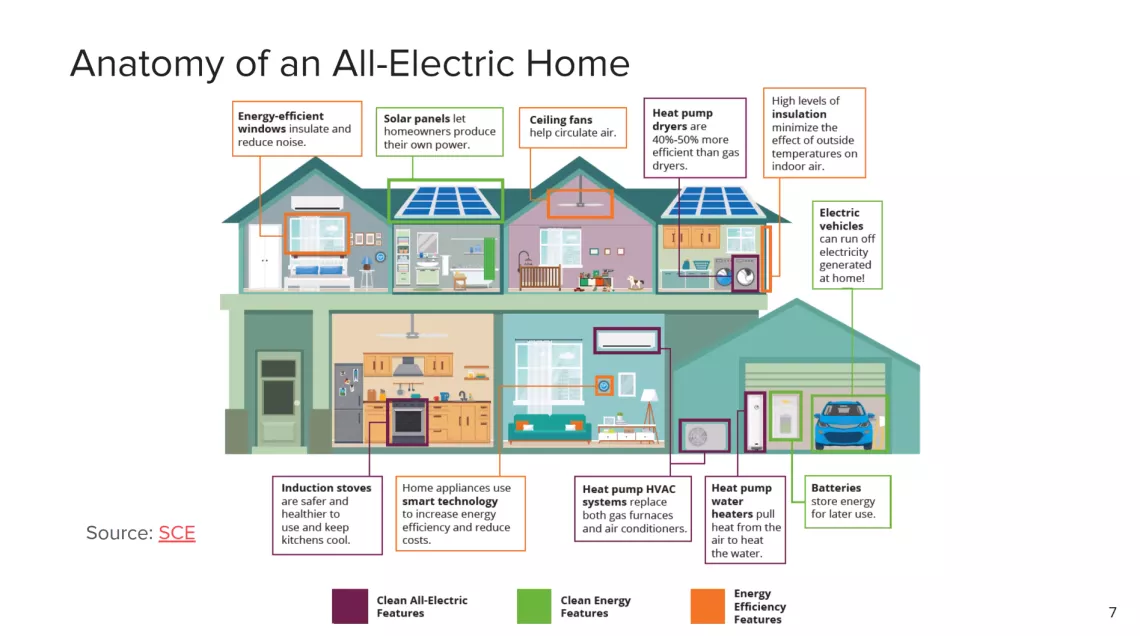By Katie Davis
A new book called The Big Fix: 7 Practical Steps to Save Our Planet by Hal Harvey and Justin Gillis argues that we all need to become “green citizens,” focusing on a “relatively small number of public policies that can, over time, bring about sweeping change.” A big one they point to is local building codes as buildings are a huge source of carbon emissions.
Now is a great time to be a green citizen locally and support carbon-neutral building codes. Ventura County just passed a building electrification ordinance and Santa Barbara County will be voting on one soon, as will Goleta and Carpinteria, which are collaborating with the county. The cities of Santa Barbara and Ojai have already phased out gas in new construction.
It’s easy. Write to Santa Barbara County Supervisors (sbcob@countyofsb.org) and tell them you favor all-electric new construction and to vote YES on a building reach code or ordinance. Also reach out to your city council members and urge them to phase out gas in buildings. We will not be alone. Right now, 68 cities and counties in California have implemented reach codes to shift to all-electric new construction and many more are in consideration.
All-electric homes are better for our health. The combustion of gas inside our homes produces harmful indoor air pollution, specifically nitrogen dioxide, carbon monoxide, nitric oxide, formaldehyde, acetaldehyde, and ultrafine particles. These odorless and undetectable gas combustion pollutants can cause respiratory diseases. Lawrence Berkeley National Laboratory found that air pollution levels in the majority of homes with gas stoves exceed EPA’s definition of clean air, i.e. air pollution levels indoors in these homes would be illegal if found outdoors. One study found that gas stoves may be responsible for up to 12 percent of childhood asthma cases.
It also lowers the cost of new construction and supports affordable housing. All-electric homes can be cheaper to build than gas-heated buildings and cheaper to live in. Ensuring all new construction is built without gas hookups will help developers build more quickly and affordably as there will be no need for new costly gas infrastructure — an advantage in the ongoing housing crisis. An analysis by the Statewide Utility Codes and Standards Team found that building all-electric reduced construction costs on average $5,000 for single-family homes and over $2,000 per unit in a multi-family building. In addition, the California Public Utilities Commission just announced it is removing subsidies for gas hookups further increasing the cost to expand gas pipes to new homes. While subsidies under the Inflation Reduction ACT will further lower the cost of construction and appliances for new electric homes.
Building all-electric will also save costs in the long-term as we transition to a carbon-neutral economy. Gas distribution pipeline extensions to new homes are expected to become stranded assets well before the end of their useful life as more buildings electrify over the coming years. Stopping investments in new gas infrastructure is a fiscally prudent strategy to avoid saddling ratepayers and taxpayers with the costs of maintaining and ultimately decommissioning stranded gas infrastructure.
It will also make homes and businesses safer and more resilient in the face of climate change. California is experiencing an increasing occurrence of extreme heat waves, with practically each summer breaking previously held record temperatures. Many of us in Santa Barbara and Ventura counties, particularly low-income families, do not have air conditioning and are not prepared to adapt to these heat waves, posing new health and safety risks. Air conditioning is an important bonus from replacing gas furnaces with electric heat pump space heaters, as the heat pumps can operate in reverse and provide high efficiency cooling when needed. Electrification offers greater comfort, safety, and climate resiliency when temperatures peak.
Lastly, gas pipelines are vulnerable to methane leakage, over-pressurization, earthquakes and fires. In our region, gas infrastructure is located in particularly dangerous, populated areas that pose an on-going risk to area residents. For instance, he Ventura Compressor Station that sends gas to Santa Barbara County is in a populated area next to an elementary school and the La Goleta gas storage field (similar to the Aliso Canyon gas storage facility which had a major failure and massive gas release in 2015) is located on rapidly retreating bluffs and under UCSB with 26,000 students and Goleta Beach with 1.5 million visitors a year. Communities with gas pipelines face increased risks of fires as gas pipeline leaks are highly flammable. Aging pipelines and associated equipment, and inflexible pipeline materials are vulnerable to shifts in the earth and buildings that put additional stress on pipelines, causing cracks and methane leaks.
Electricity in our region is rapidly getting cleaner and more reliable, with Central Coast Community Energy on track to meet its goal of 100% renewable energy by 2030, and the Clean Power Alliance procuring renewable energy for most of its Ventura customers. The deployment of battery backup has helped us avert outages even during extreme heat events, and new electric homes will be built with solar panels and new, efficient appliances. As a result, shifting to electric power in our buildings dramatically lowers greenhouse gas emissions across our region. Upgrading our building codes is true climate leadership and green citizenry in action.
Finally, you can choose electric options for your own home. If you need a new oven, consider getting an induction stove. If you need to replace your water heater or home heating system, replace your polluting gas versions for clean and efficient heat pump technology. Let's be the change we want to see in the world.
